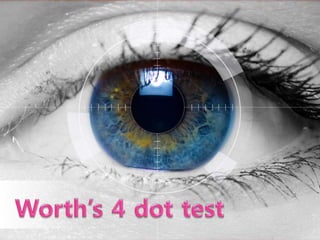
Worth4dot-Thai Edition
- 2. Purpose Worth 4 dot test เป็นวิธีการประเมินการทางานของตาในรูปแบบ Sensory Test ตรวจหาความบกพร่องในการทางานของBinocular Single visionและการรวม ภาพของตาทั้งสองข้างให้เป็นภาพเดียว (Flat Fusion) เพื่อตรวจหาความผิดปกติของตาว่า • มีการกดทับการมองเห็น Supressionในตาข้างหนึ่ง(Unilatteral Scotoma) เกิดขึ้นหรือไม่ • ตรวจว่าการมองเห็นภาพซ้อน(Dipopia)เกิดขึ้นหรือไม่
- 3. Equipment -Worth’s 4 Dots target/ or Worth’s 4 Dots Chart on Phoropter -Hand held Worth 4 Dot flashlight(for test at near 16”) -Red-green glasses
- 4. • Test at Far • ถ้าคนไข้มีค่าสายตาให้ใช้ค่าแว่นในการตรวจหรือใส่ค่าสายตาลงบนPhoroptor • สวมแว่น Red –Green glass ทับแว่นอันเดิมที่ ให้สีแดง (Red glass) ด้านตาขวา และสีเขียว (Green glass) ด้านตาซ้าย • ให้คนไข้ยืนห่างจากChart 6 เมตร เปิด Chart -Worth’s four dot เพื่อทาการตรวจถ้า เป็นแบบกล่องไฟที่ติดอยู่ผนังห้องให้เปิดกล่องไฟเพื่อทาการตรวจ • ถามคนไข้ว่าเห็นจุดที่แสดงอยู่ใน Chart ทั้งหมดกี่จุด
- 5. • Test at Near -ถือ Hand held Worth 4 Dot flashlight ห่างจากTargat 16” -ให้คนไข้ดูจุดแสงที่แสดงอยู่ในฉาก -ถามคนไข้ว่าเห็นจุดที่แสดงอยู่ในChart ทั้งหมดกี่จุด
- 6. ถามคนไข้ --> เห็นจุดทั้งหมดกี่จุด ถ้าเห็น สี่ จุด แสดงว่า การมองเห็นปกติ “Normal flat fusion” Fusion os OD
- 7. ถ้าเห็น สอง จุดเป็นสีแดง แสดงว่า ตาข้างซ้ายมี การกดทับทาให้สูญเสียในการมองเห็น Suppress ing Left eye Suppressing Left eye os
- 8. ถ้าเห็น สามจุดเป็นสีเขียว แสดงว่า ตาข้างขวามีการกดทับทาให้สูญเสีย การมองเห็น “Suppressing Right eye” Suppressing Right eye
- 9. ถ้าเห็นจุดเป็น ห้า จุด (Diplopia) ให้ถามต่อว่า เห็นจุดสี เขียวอยู่ในตาแหน่งไหน ซ้าย ขวา บน หรือล่าง ของจุดสี แดง ถ้าเห็นจุดสีแดงอยู่ด้านขวาของจุดสีเขียววินิจฉัยว่า เป็น “Uncrossed Diplopia (ESO deviation )” Uncrossed Diplopia (ESO deviation)
- 10. ถ้าเห็นจุดสีแดงอยู่ด้านซ้ายของจุดสีเขียว วินิจฉัย ว่า เป็น “Crossed Diplopia (EXO deviation )” Crossed Diplopia Exo deviation
- 11. ถ้าเห็นจุดสีแดงอยู่ด้านบนของจุดสี เขียววินิจฉัยว่า เป็น “LEFT HYPER deviation” LEFT HYPER deviation
- 12. ถ้าเห็นจุดสีแดงอยู่ด้านล่างของจุดสีเขียว วินิจฉัยว่า เป็น “RIGHT HYPER deviation” RIGHT HYPER deviation
- 13. Treatment 1. Nonsurgical managemen t • Refractive error management • Occlusion Therapy • Prism Therapy • Orthoptic Training • Botulinum Toxin 2. Surgical management
- 14. References • Clinical Procedure for Ocular Examination - 3rd editionby Daniel Kurtz and Nancy B. Carlson • เอกสารประกอบการเรียน Introduction to optometric clinic by Pornpatcharin Wongsaisri MD.OD.Faculty of Optometry.RangsitUniversit • ตาราจักษุวิทยาเด็กและตาเข-ชมรมจักษุวิทยาเด็ก และตาเข ราชวิทยาลัยจักษุแพทย์แห่งประเทศไทย. พิมพ์ครั้งที่1.2546
- 15. Created by Aon-Uma Thongnual 5501410 Sukree Jehsoh 5504889 Faculty of Optometry Rangsit University
